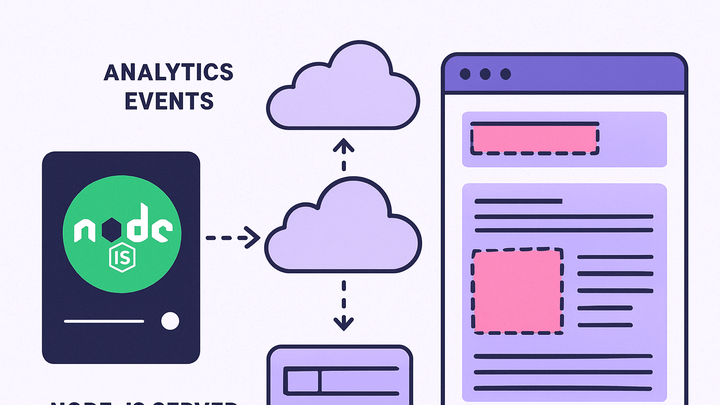Published on 2025-06-22T04:00:40Z
What is a Node in Analytics? Examples with PlainSignal & GA4
In analytics, the term Node can have multiple meanings depending on context. On the server side, it often refers to Node.js, an open-source JavaScript runtime used to ingest, process, and forward analytical data in real time. On the client side, a DOM (Document Object Model) Node represents an element in a web page that can be tracked for user interactions such as clicks, hovers, or form submissions.
By leveraging Node.js, teams can build custom back-end pipelines to send events to analytics platforms like PlainSignal or Google Analytics 4 (GA4) with the Measurement Protocol. Meanwhile, understanding DOM nodes allows marketers and developers to precisely instrument element-level tracking on the front end, capturing user behavior without relying solely on tag managers.
Below, we explore both definitions, showcase code examples for integrating PlainSignal’s cookie-free analytics and GA4, and share best practices to ensure secure, performant, and privacy-conscious data collection.
Node
A Node in analytics refers to both a server-side JavaScript runtime (Node.js) and a DOM element used for event tracking.
Multiple Meanings of Node in Analytics
The term Node in analytics can refer to different concepts depending on where you work within the stack.
-
Server-side runtime (node.js)
Node.js is a JavaScript runtime built on Chrome’s V8 engine. Analytics teams use it to build custom data ingestion pipelines, apply business logic, and forward events to analytics services in real time.
-
Event-driven architecture
Node.js excels at handling asynchronous I/O, making it ideal for high-throughput analytics workflows.
-
Custom integrations
You can write scripts in Node.js to transform, enrich, or filter data before sending it to platforms like PlainSignal or GA4.
-
-
Client-side tracking (dom node)
A DOM Node represents any element in an HTML document, such as buttons, links, and forms, which you can hook into for user-interaction tracking.
-
Element selection
Use CSS selectors to target specific DOM nodes for tracking clicks or visibility events.
-
Data attributes
Embed data attributes on DOM nodes to pass metadata to your analytics payloads.
-
Implementing Analytics with Node.js
You can leverage Node.js to send analytics data both from the browser and from the server. Below are examples for PlainSignal (cookie-free) and GA4 integrations.
-
PlainSignal integration
PlainSignal offers a simple, cookieless analytics service. Use the client-side snippet for quick setup or a server-side call for advanced control.
-
Client-side snippet
Include this HTML in your page header:
<link rel="preconnect" href="//eu.plainsignal.com/" crossorigin /> <script defer data-do="yourwebsitedomain.com" data-id="0GQV1xmtzQQ" data-api="//eu.plainsignal.com" src="//cdn.plainsignal.com/plainsignal-min.js"></script> -
Server-side request
Use Node.js fetch or an HTTP client to dispatch events:
import fetch from 'node-fetch'; async function sendEvent(eventName, payload) { await fetch('https://eu.plainsignal.com/api/track', { method: 'POST', headers: { 'Content-Type': 'application/json' }, body: JSON.stringify({ id: '0GQV1xmtzQQ', event: eventName, data: payload }) }); } sendEvent('page_view', { path: '/home' });
-
-
GA4 integration
Google Analytics 4 provides both a front-end snippet and a Measurement Protocol for server-side events.
-
Client-side snippet
Add this to your HTML to load gtag.js:
<script async src="https://www.googletagmanager.com/gtag/js?id=G-XXXXXXXXXX"></script> <script> window.dataLayer = window.dataLayer || []; function gtag(){dataLayer.push(arguments);} gtag('js', new Date()); gtag('config', 'G-XXXXXXXXXX'); </script> -
Server-side measurement protocol
Send events via HTTP using Node.js:
import fetch from 'node-fetch'; const MEASUREMENT_ID = 'G-XXXXXXXXXX'; const API_SECRET = 'YOUR_API_SECRET'; async function trackEvent(eventName, clientId) { await fetch( `https://www.google-analytics.com/mp/collect?measurement_id=${MEASUREMENT_ID}&api_secret=${API_SECRET}`, { method: 'POST', headers: { 'Content-Type': 'application/json' }, body: JSON.stringify({ client_id: clientId, events: [{ name: eventName }] }) } ); } trackEvent('purchase', '555');
-
Best Practices for Node-based Analytics
Follow these guidelines to ensure data quality, privacy, and performance when using Node in your analytics stack.
-
Security and privacy
Protect user data and comply with regulations.
-
Use https
Always send events over secure channels to prevent interception.
-
Handle pii properly
Avoid sending personally identifiable information unless you have explicit consent.
-
-
Performance optimization
Optimize your Node.js analytics pipeline for speed and reliability.
-
Batch events
Group multiple events into a single network request to reduce overhead.
-
Asynchronous calls
Use non-blocking I/O to prevent analytics code from slowing down your application.
-
